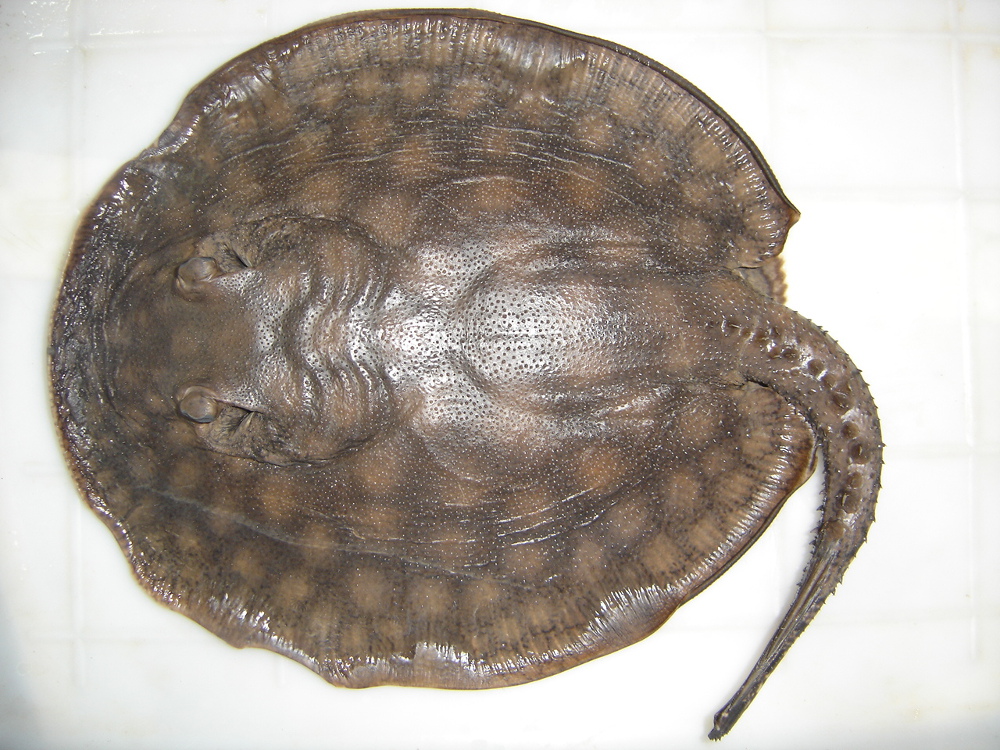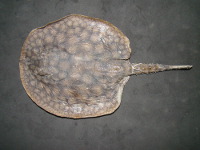Potamotrygon humerosa
Garman, 1913
Smooth back river stingray
Classification: Elasmobranchii Myliobatiformes Potamotrygonidae
Reference of the original description
The Plagiostomia (Sharks, Skates and Rays). Memoirs of the Museum of Comparative Zoology at Harvard College, 36, 1–528
The Plagiostomia (Sharks, Skates and Rays). Memoirs of the Museum of Comparative Zoology at Harvard College, 36, 1–528
Synonyms / new combinations and misspellings
Potamotrygon cf. humerosa, Potamotrygon humerosus
Potamotrygon cf. humerosa, Potamotrygon humerosus
Description :
Citation: Potamotrygon humerosa Garman, 1913: In: Database of modern sharks, rays and chimaeras, www.shark-references.com, World Wide Web electronic publication, Version 04/2024
Please send your images of "Potamotrygon humerosa" to info@shark-references.com

Potamotrygon humerosa Garman, 1913 © João Paulo Capretz Batista da Silva

Potamotrygon humerosa Garman, 1913 © João Paulo Capretz Batista da Silva
Common names
Smooth back river stingray
Smooth back river stingray
Short Description
Diagnosis after DA SILVA & DE CARVALHO, 2015 [22907]: A species of Potamotrygon from the Amazon basin distinguished from congeners by the following combination of characters: dark brown dorsally, with slender dorsal reticulate pattern delimiting rounded, fragmented spaces composed of small dark beige spots with diameter smaller than eyes; dorsal tail with lateral black stripes; ventral tail medially white, with gray margins; distal tail dark gray with vermiculate white spots randomly distributed; disc thick at pectoral bases; spiracles small, their aperture equivalent to one and a half times eye length; clearly demarcated labial ridges at lower jaw corners; small triangular monocuspidate teeth in males and trapezoidal and tricuspidate teeth in females; dorsal tail spines usually in a single irregular row; lateral tail spines developed and distributed from tail-base to region posterior to caudal sting origin; submarginal tubercles rare and isolated. Potamotrygon humerosa can be distinguished from P. orbignyi by its dorsal coloration composed exclusively of broad rounded fragmented spaces within slender reticulations (vs. reticulate pattern usually delimiting hexagonal spaces, or reticulation surrounding circular, ringed or rosette-like markings), smaller tail length (means 82% vs. 92% DW, respectively), tail with conspicuous lateral spines from base to origin of caudal sting (lacking in P. orbignyi); lower number of total (means 119.4 vs. 125.5, respectively) and diplospondylic vertebrae (84.5 vs. 91.5, respectively), and a smaller size at maturity (means 255.3 mm DW in males and 268.7 mm DW in females vs. 346.2 mm DW in males and 363.2 mm DW in females in P. orbignyi). Potamotrygon humerosa can be distinguished from P. marinae by lacking vivid, wide and rounded orange blotches and spots within reticulations on dorsal disc, by its mostly white ventral disc color (vs. mostly dark gray in P. marinae), by having a greater branchial basket length (means 18.3% vs. 16.9% DW, respectively), and by its lower number of mesopterygial radials (means 15.4 vs. 18, respectively).
Diagnosis after DA SILVA & DE CARVALHO, 2015 [22907]: A species of Potamotrygon from the Amazon basin distinguished from congeners by the following combination of characters: dark brown dorsally, with slender dorsal reticulate pattern delimiting rounded, fragmented spaces composed of small dark beige spots with diameter smaller than eyes; dorsal tail with lateral black stripes; ventral tail medially white, with gray margins; distal tail dark gray with vermiculate white spots randomly distributed; disc thick at pectoral bases; spiracles small, their aperture equivalent to one and a half times eye length; clearly demarcated labial ridges at lower jaw corners; small triangular monocuspidate teeth in males and trapezoidal and tricuspidate teeth in females; dorsal tail spines usually in a single irregular row; lateral tail spines developed and distributed from tail-base to region posterior to caudal sting origin; submarginal tubercles rare and isolated. Potamotrygon humerosa can be distinguished from P. orbignyi by its dorsal coloration composed exclusively of broad rounded fragmented spaces within slender reticulations (vs. reticulate pattern usually delimiting hexagonal spaces, or reticulation surrounding circular, ringed or rosette-like markings), smaller tail length (means 82% vs. 92% DW, respectively), tail with conspicuous lateral spines from base to origin of caudal sting (lacking in P. orbignyi); lower number of total (means 119.4 vs. 125.5, respectively) and diplospondylic vertebrae (84.5 vs. 91.5, respectively), and a smaller size at maturity (means 255.3 mm DW in males and 268.7 mm DW in females vs. 346.2 mm DW in males and 363.2 mm DW in females in P. orbignyi). Potamotrygon humerosa can be distinguished from P. marinae by lacking vivid, wide and rounded orange blotches and spots within reticulations on dorsal disc, by its mostly white ventral disc color (vs. mostly dark gray in P. marinae), by having a greater branchial basket length (means 18.3% vs. 16.9% DW, respectively), and by its lower number of mesopterygial radials (means 15.4 vs. 18, respectively).
Distribution
Occurs in the Amazon River, and in lower reaches of the effluents Canumã, Negro, Abacaxis, Trombetas, Tapajós, and Pará, but appears to be absent from the Tocantins-Araguaia basin [22907]
Occurs in the Amazon River, and in lower reaches of the effluents Canumã, Negro, Abacaxis, Trombetas, Tapajós, and Pará, but appears to be absent from the Tocantins-Araguaia basin [22907]
Biology
freshwater
freshwater
Remarks
shark-references Species-ID=7967; CITES: (see: Protected Species for more details) Convention on International Trade in Endangered Speciesof Wild Fauna and Flora annex: III; Council Regulation 2017/160 annex: C
shark-references Species-ID=7967; CITES: (see: Protected Species for more details) Convention on International Trade in Endangered Speciesof Wild Fauna and Flora annex: III; Council Regulation 2017/160 annex: C
Parasites (arranged by Jürgen Pollerspöck)
Monogenea
Monogenea
- Potamotrygonocotyle chisholmae Domingues & Marques, 2007 [14308]
- Potamotrygonocotyle dromedarius Domingues & Marques, 2007 [22565]
- Potamotrygonocotyle rionegrense Domingues, Pancera & Marques, 2007 [14549]
- Potamotrygonocotyle tsalickisi Mayes, Brooks & Thorson, 1981 [14308] [14549] [22565]
















